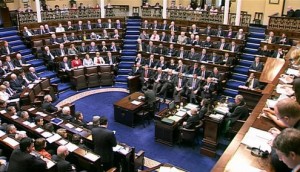El parlamento irlandés pone en activo su ingente archivo
Oireachtas Broadcasting Unit (OBU) integra un sistema de archivo sin cintas en el parlamento irlandés basado en servidores y gestión de almacenamiento Spectrum y MediaGrid de Omneon. La ingesta del material procedente de las dos cámaras irlandesas y de las diferentes salas de reuniones de las comisiones está controlado y automatizado desde un sistema IBIS.
 Oireachtas Broadcasting Unit (OBU), empresa subsisiaria de Irish National Archive, utilizará el sistema de almacenamiemto y la plataforma de gestión y procesado de activos de Omneon en el parlamento irlandés. Este sistema suministrado por el distribuidor de Omneon Eurotek, totalmente libre de cintas, permitirá contar con material en alta calidad para su consulta inmediata o para ponerlo a disposición de aquellos broadcasters irlandeses que lo demanden.
Oireachtas Broadcasting Unit (OBU), empresa subsisiaria de Irish National Archive, utilizará el sistema de almacenamiemto y la plataforma de gestión y procesado de activos de Omneon en el parlamento irlandés. Este sistema suministrado por el distribuidor de Omneon Eurotek, totalmente libre de cintas, permitirá contar con material en alta calidad para su consulta inmediata o para ponerlo a disposición de aquellos broadcasters irlandeses que lo demanden.
OBU recoge directamente en los servidores Omneon Spectrum las señales procedentes de las dos cámaras del parlamento irlandés (conocidas como Oireachtas) así como de las diferentes salas de reuniones de las comisiones localizadas en Leinster House en Dublín. La ingesta del material está controlada y automatizada desde un sistema IBIS.
Cuando el Omneon Spectrum ingesta una fuente, automáticamente se genera una copia en alta resolución que se transfiere y almacena en un MediaGrid de 24 TB, donde el contenido queda accesible para control de calidad y archivo permanente. Durante la propia ingesta, la solución Omneon ProBrowse crea simultáneamente un proxy de baja resolución que se utiliza para gestión de media, y automatización para browsing y creación de EDL.
John Brady, director técnico de OBU, ha comentado que “como parte del Irish National Archive, tenemos el deber de garantizar al cien por cien la fiabilidad del registro de toda la actividad parlamentaria. La plataforma Omneon ofrece alto rendimiento y fiabilidad en tiempo real, al mismo tiempo que su potencia de procesamiento garantiza un proceso de control de calidad automatizado y una rápida disposición de las EDL. Gracias a esta plataforma hemos sido capaces de implementar una mayor fiabilidad en un flujo de trabajo eficiente basado en proxy siendo totalmente compatible con múltiples soluciones de edición, al mismo tiempo que hemos aprovechado para llevar a cabo una rápida restauración del material almacenado, reduciendo espacio, costes y consumo energético”.
Did you like this article?
Subscribe to our NEWSLETTER and you won't miss anything.


